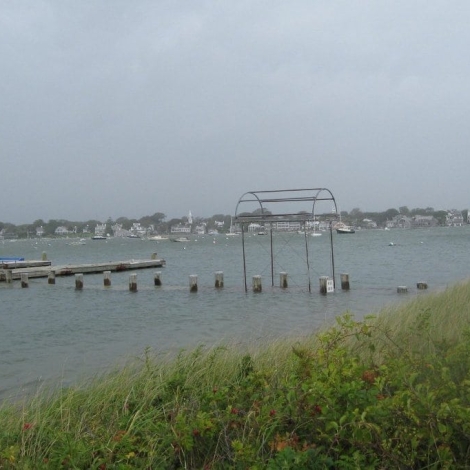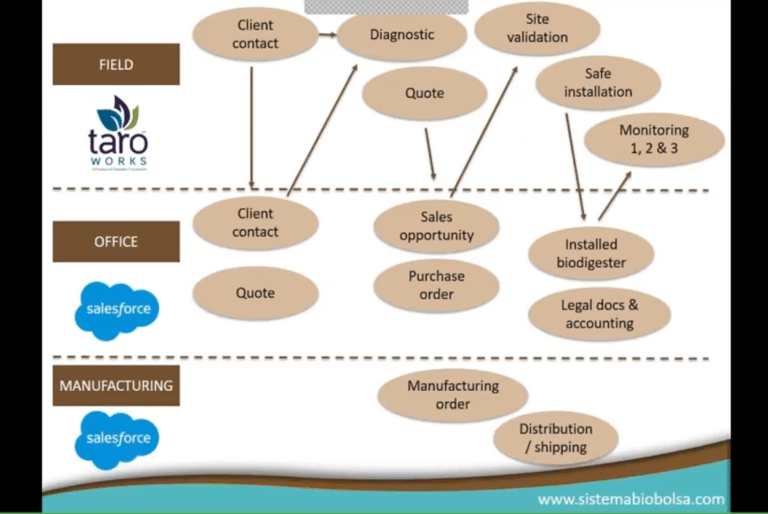Martha’s Vineyard is a bellwether of climate change, sea level rise and socioeconomic dynamics. The “Vineyard,” as it is called, is a US island in Cape Cod south of mainland Massachusetts. It is an enclave for the wealthy, the summer getaway for the likes of Hollywood stars, the Obama family and others. In spite of its affluence, Martha’s Vineyard’s struggles to prepare for a changing climate, and its effort holds lessons for island and coastal communities worldwide.
The island is approximately 225 square kilometers (90 square miles) and, like many coastal communities, even those in developing countries, its economy depends heavily on tourism. Also like many communities in developing countries, its economic landscape has changed fast. Fewer than 75 years ago, the island was self-sustaining from grazing, agriculture and local fisheries. Now it lurches through rapid changes, both economic and environmental.
The Vineyard imports almost all of its resources, with the exception of drinking water, and it is at risk at multiple levels. In the last few years, there has been noticeable coastal erosion, increased flooding during storms, damage to existing infrastructure, and degraded water quality in coastal ponds, mostly from wastewater, climate change and environmental impacts from land developments.
Infrastructure
Infrastructure tops the list of problems. There is a new $45 million drawbridge being built in an area of low elevation. In the near future, the roads to the bridge will be underwater when storms strike, considering the latest IPCC projections of a possible 80cm (32in) sea level rise by the end of the century. The drawbridge may survive but there is a strong possibility that it will not be accessible because the roads could wash out.

The island’s beaches are eroding away and the problem is only expected to grow worse. Photo by Camron Adibi / E4C
Considerations
The outlook raises questions. Are roads and bridges no longer cost effective? Will water transport be more reliable? If so, what would an adaptable infrastructure look like that allows for a working waterfront and more water transport?
Coastal Impacts
Both sea level and storm intensity are expected to increase, and both will exacerbate coastal erosion. Hurricane Sandy damaged a shoreline road and incited a search for better infrastructure solutions. There was a proposal that would build a dune that could help prevent flooding during a 50-year storm. Local voters opted for building a new road further inland with a small section to be built through a wetland.
Considerations
When is it appropriate to remove existing hard infrastructure to allow for more of a fluid coastline? How can soft infrastructure be adapted and allow for more naturalized beach replenishment, opposed to hardening the shoreline to keep sand in one place? And the most difficult question: how do you present an alternative solution to an emotionally charged audience?
Nutrient Management and Wastewater
Nutrient loading from onsite wastewater systems is probably the greatest challenge facing islands like the Vineyard, which depend on clean shores and rivers for its summer tourist economy. More than 90% of the wastewater flows into the Vineyard’s coastal ponds comes from onsite septic systems. Local and state laws allow for a Title V septic system, which does not treat nitrogen or phosphorus. Nutrient loading (primarily nitrogen from urine) causes deterioration of groundwater, ponds, bays, and coastal water quality. During the summer months, bacteria outbreaks have closed coastal ponds to swimming and shellfish harvesting.
Considerations
Central sewage would cost millions, if not billions of dollars. Composting toilets are not socially accepted. What does a small island do with its wastewater? The four usual approaches to wastewater treatment are centralized, satellite or cluster plants, or individual treatment on-site, and they all remove nitrogen. Are there other approaches such as capturing and recycling nitrogen?
Oyster farms create a win-win scenario that not only improve water quality but also create a local food product.
Solution: Oyster Farms
The Vineyard has opted for a solution to water quality problems that other coastal communities could learn from: Oyster farms. Shellfish are ecological engineers and filter feeders that remove nitrogen. Oyster farms create a win-win scenario that not only improve water quality but also create a local food product. More oyster farms are now being introduced to the island and they have been economically successful. The local towns are opening up more ponds to oyster farming. Local fishermen who have been struggling with strict regulations for fishing are turning to shellfish farming. To compliment the oyster farms, conservation groups and town shellfish departments have been introducing oyster propagation projects. Recently, 100 cubic yards of sea clam shells were put in a pond, followed by 250,000 juvenile oysters. Basically, they are creating sanctuaries while improving water quality. The propagation project cost approximately $60K including permits.
Solution: Fertilizer Regulation
Fertilizer regulations have been another creative, low-cost solution, thanks mostly to local conservation groups. Lawn fertilizers may account for 5 – 15 percent of the Island’s controllable nitrogen. The new regulations stipulate that fertilizer cannot be applied during winter months, or during a heavy rain. Buffer zones must protect ponds and golf courses from fertilizer, and phosphorus is prohibited.
Why phosphorus? In wastewater, phosphorus comes mostly from consumer products such as detergents, toothpaste, soaps and shampoos. Phosphorous, along with nitrogen and potassium, are found in all fertilizers and the three key ingredients in a bag of fertilizer for your garden. For commercial use, most phosphorus is mined as phosphate-bearing rock in a handful of countries with supplies of decreasing quantity and quality. Phosphorus is not usually a problem in coastal ponds, but it causes algal blooms in freshwater.
How could an island community harvest nutrients from waste to create local jobs and develop fertilizer for agriculture and landscaping?
Design challenge: Is there money in harvesting nutrients from wastewater?
Phosphorus is a finite material. In 2009, a group of researchers predicted that we have surpassed peak phosphorus production and reserves would be depleted in 25 to 50 years, which will squeeze farmers and drive up globally food prices. Because of this dilemma, new methods are being developed to remove phosphorous from wastewater in an economical way to harvest and recycle phosphorus. Nitrogen gets the most attention, but is there an unrealized economic value in the phosphorus on the Vineyard and other islands? How could the island’s wastewater treatment facilities adopt technology to harvest nutrients and possibly transfer this technology to onsite septic systems?
Drinking Water Supply
The Vineyard has an excellent aquifer that is recharged solely from rain. There has been a strong island history of protecting open spaces and land by local conservation groups. It is assumed by many that drinking water will always be high quality.
Nitrate-nitrogen is a major component of human wastewater. Nitrogen passes through septic systems virtually untreated and is introduced to the underlying groundwater. High levels of nitrates are dangerous to human health. Now, pharmaceuticals and personal care products (PPCPs), and other emerging contaminants are beginning to appear in drinking water supplies, as revealed in a study on Cape Cod in southern Massachusetts.
In 2011, the Silent Spring Institute tested 20 private drinking water wells in seven towns on Cape Cod for emerging contaminants. 85 percent of samples were contaminated, which shows that chemicals in wastewater can seep from septic systems and make their way into drinking water. Many compounds found in the study are known as endocrine disrupting chemicals or “gender benders.” In some organisms, these chemicals can change the gender of a species. Investigations are underway into the effects in humans.
Solutions: Septic Tanks and Rainwater
A theoretical scenario would seal onsite septic systems so they do not allow for leaching of compounds into groundwater. How would this be achieved in a cost-effective way that allows for minimal maintenance?
Many islands have to capture rainfall for drinking water. This could be a future scenario for the Vineyard. Is it possible to develop a systems approach in regards to the hydrologic cycle? The amounts of precipitation and evaporation are not a consideration in planning now. How would those considerations improve the planning and design process?
Solution: Composting
Composting may be a low-hanging fruit. A new state law has banned establishments from tossing out one ton or more of food waste per week. Instead, it must be sent to a composting facility. A farm on the island accepts decomposing organic material and waste from a local grocery store. Local groups are in the midst of creating a feasibility study for an islandwide composting facility. There are no figures for the amount of fertilizer that is shipped to the Vineyard each year, mostly for landscaping.
How does the island community harvest nutrients that support a local economy, not only from wastewater but also compost material, and develop fertilizer products for agricultural and landscaping uses? How could the costs for importing fertilizer products be reduced?
Farming
Local farming and local foods have gained a following on the island. Thanks to a local nonprofit, there is a strong farm-to-schools program. More recently, a forty-acre farm was purchased that had a neglected 3000 square meter (33,000 square feet) greenhouse. A nonprofit has acquired ownership of the farm and in the planning process. They envision leasing commercial farm lots, establishing a business incubator, building affordable housing for farmers and building a slaughterhouse.
And the most exciting proposal is the repurposing of the greenhouse into a hydroponics operation and with a separate aquaponics system. The greenhouse will be a zero-discharge facility, with all recycled water flowing through the hydroponic system. The goal is to establish financially self-sustaining operations. The nonprofit is also investigating biomass, wind and solar options for the greenhouse and the farm.
Ripe with Engineering Opportunity
Islands like the Vineyard have an opportunity to show how problems are solutions waiting to happen. The Vineyard has an opportunity to demonstrate the effectiveness of soft, flexible infrastructure that utilizes a working waterfront as an adaptive response, as opposed to 19th century infrastructure of roads, bridges and central wastewater treatment facilities. The Vineyard has the opportunity to demonstrate a model for nutrient harvesting of nitrogen and phosphorus from wastewater and compost. There is a need for solution-based thinking and people who have an interest in innovative design and better understanding social behavior.
The Vineyard is ripe for a design challenge. The engineers of the future are being called for duty. There are many non-profits and municipal organizations that have summer positions and need engineering minds. Engineering challenges are everywhere. It is rare to have a small island that has both the interest and the commitment. The National Science Foundation announced the greatest engineering challenges in the 21st century, and two among them were the management of the nitrogen cycle and access to clean water. Islands around the world are waiting for these solutions.

